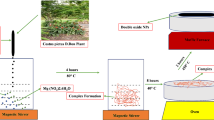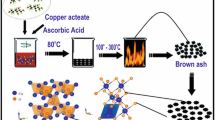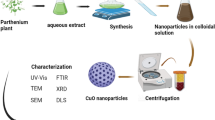Abstract
In the present work, copper oxide nanoparticles (CuO-NPs) were fabricated using two approaches, namely microwave irradiation (CuO(M)-NPs) and the green synthesis approach (CuO(G)-NPs). Their phase, purity, and structural parameters were confirmed using X-ray diffraction (XRD), and Rietveld refinement gave an average crystallite size ranging between 17 and 12 nm. Raman analysis indicated the peak shift toward a lower wavenumber in CuO (G)-NPs, attributed to a decrease in particle size due to the addition of Zanthoxylum armatum plant extract. Transmission electron microscopy (TEM) and field emission scanning electron microscopy (FE-SEM) micrographs revealed the morphology with well-defined grain boundaries for CuO(G)-NPs, while diffused grains were observed for CuO (M)-NPs synthesized without the use of plant extract indicating that the plant extract restricted the agglomeration of CuO-NPs. X-ray photoelectron spectroscopy (XPS) showed chemisorbed species on the surface of CuO (G)-NPs, which, in turn, influenced their antimicrobial activity. Although no difference in the optical bandgap of both NPs is noticeable, the absorption intensity was higher for CuO (G)-NPs. Thermogravimetric analysis (TGA) corroborated XPS findings as it revealed that CuO (G)-NP sample underwent more weight loss as the temperature increased owing to the adsorption of organic moieties. The antimicrobial activity of both samples was also evaluated using different pathogenic bacteria and yeast strains: Bacillus subtilis, Escherichia coli and Candida albicans. The highest zone of inhibition of 23.0 ± 0.5 mm was observed for B. subtilis. The present study exhibited a swift and low-temperature protocol to enhance the antimicrobial performance of the CuO-NPs. The utilization of Z. armatum has the added advantage that nanotechnology processing industries can use this plant.













Similar content being viewed by others
Abbreviations
- CuO (G)-NPs:
-
Copper oxide nanoparticles obtained via a green method
- CuO (M)-NPs:
-
Copper oxide nanoparticles obtained using microwave irradiation
- DW:
-
Deionized water
- SAED:
-
Selected area electron diffraction
References
Ahamed M et al (2014) Synthesis, characterization, and antimicrobial activity of copper oxide nanoparticles. J Nanomater. https://doi.org/10.1155/2014/637858
Ahmad T et al (2005) Canted antiferromagnetism in copper oxide nanoparticles synthesized by the reverse-micellar route. Solid State Sci 7(7):891–895
Akshay M et al (2022) Choice of binder on conversion type CuO nanoparticles toward building high energy li-ion capacitors: an approach beyond intercalation. Adv Mater Technol. https://doi.org/10.1002/admt.202200423
Alam F, Ashraf M (2018) Zanthoxylum armatum DC extracts from fruit, bark and leaf induce hypolipidemic and hypoglycemic effects in mice-in vivo and in vitro study. BMC Complement Altern Med 18(1):1–9
Andualem WW et al (2020) Synthesis of copper oxide nanoparticles using plant leaf extract of Catha edulis and its antibacterial activity. J Nanotechnol. https://doi.org/10.1155/2020/2932434
Barwant M et al (2022) Eco-friendly synthesis and characterizations of Ag/AgO/Ag2O nanoparticles using leaf extracts of Solanum elaeagnifolium for antioxidant, anticancer, and DNA cleavage activities. Chem Pap. https://doi.org/10.1007/s11696-022-02178-0
Bhattacharjee A, Ahmaruzzaman M (2016) CuO nanostructures: facile synthesis and applications for enhanced photodegradation of organic compounds and reduction of p-nitrophenol from aqueous phase. RSC Adv 6(47):41348–41363
Bhaumik A et al (2014) Significant enhancement of optical absorption through nano-structuring of copper based oxide semiconductors: possible future materials for solar energy applications. Phys Chem Chem Phys 16(22):11054–11066
Chakraborty N et al (2022) Green synthesis of copper/copper oxide nanoparticles and their applications: a review. Green Chem Lett Rev 15(1):187–215
Chauhan A et al (2021) Structural and optical properties of copper oxide nanoparticles: a study of variation in structure and antibiotic activity. J Mater Res 36(7):1496–1509
Cheng L et al (2010) Preparation, characterization, and electrochemical application of mesoporous copper oxide. Mater Res Bull 45(2):235–239
Cuong HN et al (2022) New frontiers in the plant extract mediated biosynthesis of copper oxide (CuO) nanoparticles and their potential applications: a review. Environ Res 203:111858
Dar M et al (2009) Versatile synthesis of rectangular shaped nanobat-like CuO nanostructures by hydrothermal method; structural properties and growth mechanism. Appl Surf Sci 255(12):6279–6284
Deng D et al (2012) Antioxidative effect of lactic acid-stabilized copper nanoparticles prepared in aqueous solution. J Mater Chem 22(45):23989–23995
Desalegn T et al (2021) Green synthesis of CuO nanostructures using Syzygium guineense (Willd.) DC plant leaf extract and their applications. J Nanostruct 11(1):81–94
Dirkse TP (2016) Copper, Silver, Gold & Zinc, Cadmium, Mercury Oxides & Hydroxides, vol 23. Elsevier, Netherlands
Ghotekar S (2019) A review on plant extract mediated biogenic synthesis of CdO nanoparticles and their recent applications. Asian J Green Chem 3(2):187–200
Ghotekar S et al (2021) Environmentally friendly synthesis of Cr2O3 nanoparticles: characterization, applications and future perspective─ a review. Case Stud Chem Environ Eng 3:100089
Ghotekar S et al (2022) Recent advances in synthesis of CeVO4 nanoparticles and their potential scaffold for photocatalytic applications. Top Catal. https://doi.org/10.1007/s11244-022-01630-5
Goswami A, Raul P, Purkait M (2012) Arsenic adsorption using copper (II) oxide nanoparticles. Chem Eng Res Des 90(9):1387–1396
Holder CF, Schaak RE (2019) Tutorial on powder X-ray diffraction for characterizing nanoscale materials. ACS Publ 13(7):7359–7365
Holzwarth U, Gibson N (2011) The Scherrer equation versus the Debye-Scherrer equation. Nat Nanotechnol 6(9):534–534
Hong Z-S, Cao Y, Deng J-F (2002) A convenient alcohothermal approach for low temperature synthesis of CuO nanoparticles. Mater Lett 52(1–2):34–38
Iqbal T et al (2020) Copper oxide nanosheets prepared by facile microplasma electrochemical technique with photocatalytic and bactericidal activities. J Mater Sci Mater Electron 31(19):16649–16660
Kashid Y et al (2022) Bio-inspired sustainable synthesis of silver chloride nanoparticles and their prominent applications. J Indian Chem Soc 99:100335
Katwal R et al (2015) Electrochemical synthesized copper oxide nanoparticles for enhanced photocatalytic and antimicrobial activity. J Ind Eng Chem 31:173–184
Kumari P et al (2017) Mechanistic insight to ROS and apoptosis regulated cytotoxicity inferred by green synthesized CuO nanoparticles from Calotropis gigantea to embryonic zebrafish. Sci Rep 7(1):1–17
Lee H-J et al (2011) Biological synthesis of copper nanoparticles using plant extract. Nanotechnology 1(1):371–374
Makuła P, Pacia M, Macyk W (2018) How to correctly determine the band gap energy of modified semiconductor photocatalysts based on UV–Vis spectra. ACS Publ 9:6814–6817
Marzban A et al (2022) Biogenesis of copper nanoparticles assisted with seaweed polysaccharide with antibacterial and antibiofilm properties against methicillin-resistant staphylococcus aureus. J Drug Deliv Sci Technol 74:103499
Mirza AU et al (2019) Copper oxide nanomaterials derived from Zanthoxylum armatum DC. and Berberis lycium Royle plant species: characterization, assessment of free radical scavenging and antibacterial activity. Chem Biodivers 16(8):e1900145
Mishra SR, Ahmaruzzaman M (2022) CuO and CuO-based nanocomposites: Synthesis and applications in environment and energy. Sustain Mater Technol 33:e00463
Momeni M, Ghayeb Y, Menati M (2016) Facile and green synthesis of CuO nanoneedles with high photo catalytic activity. J Mater Sci Mater Electron 27(9):9454–9460
Murthy HA et al (2018) A review on green synthesis and applications of Cu and CuO nanoparticles. Mater Sci Res India 16:252–260
Murthy HA et al (2021) Enhanced multifunctionality of CuO nanoparticles synthesized using aqueous leaf extract of Vernonia amygdalina plant. Results Chem 3:100141
Nagore P et al (2021) Structural properties and antimicrobial activities of Polyalthia longifolia leaf extract-mediated CuO nanoparticles. BioNanoScience 11(2):579–589
Naika HR et al (2015) Green synthesis of CuO nanoparticles using Gloriosa superba L. extract and their antibacterial activity. J Taibah Univ Sci 9(1):7–12
Nikam A et al (2019) A review on plant extract mediated green synthesis of zirconia nanoparticles and their miscellaneous applications. J Chem Rev 1(3):154–163
Olga M et al (2022) Antimicrobial properties and applications of metal nanoparticles biosynthesized by green methods. Biotechnol Adv 58:107905
Pandit C et al (2022) Biological agents for synthesis of nanoparticles and their applications. J King Saud University-Sci 34(3):101869
Ramesh A et al (2018) Facile green synthesis of Fe3O4 nanoparticles using aqueous leaf extract of Zanthoxylum armatum DC. for efficient adsorption of methylene blue. J Asian Ceram Soc 6(2):145–155
Ren G et al (2009) Characterisation of copper oxide nanoparticles for antimicrobial applications. Int J Antimicrob Agents 33(6):587–590
Rudresha K et al (2012) Synthesis and characterization of green CuO using centella asiatica plant leaf extrct: electrochemical and photocatalytic activities. Adv Mater Lett 4:195–200
Sarangi B, Mishra SP, Behera N (2022) Advances in green synthesis of ZnS nanoparticles: an overview. Mater Sci Semicond Process 147:106723
Sarraf M et al (2022) Metal/metalloid-based nanomaterials for plant abiotic stress tolerance: an overview of the mechanisms. Plants 11(3):316
Siddiqui H, Parra MR, Haque FZ (2018) Optimization of process parameters and its effect on structure and morphology of CuO nanoparticle synthesized via the sol− gel technique. J Sol-Gel Sci Technol 87(1):125–135
Singh, T.P. and O.M. Singh, (2011) Phytochemical and pharmacological profile of Zanthoxylum armatum DC.-an overview
Sun L et al (2005) Synthesis and characterization of CuO nanoparticles from liquid ammonia. Mater Res Bull 40(6):1024–1027
Svintsitskiy DA et al (2013) In situ XRD, XPS, TEM, and TPR study of highly active in CO oxidation CuO nanopowders. J Phys Chem C 117(28):14588–14599
Tran TH, Nguyen VT (2014) Copper oxide nanomaterials prepared by solution methods, some properties, and potential applications: a brief review. Int Sch Res Not. https://doi.org/10.1155/2014/856592
Tran TV et al (2022) Green synthesis of ZrO2 nanoparticles and nanocomposites for biomedical and environmental applications: a review. Environ Chem Lett. https://doi.org/10.1007/s10311-021-01367-9
Valodkar M et al (2011) Biocompatible synthesis of peptide capped copper nanoparticles and their biological effect on tumor cells. Mater Chem Phys 128(1–2):83–89
Verma R et al (2020) Antimicrobial potential of Ag-doped ZnO nanostructure synthesized by the green method using Moringa oleifera extract. J Environ Chem Eng 8(3):103730
Wang H et al (2002) Preparation of CuO nanoparticles by microwave irradiation. J Cryst Growth 244(1):88–94
Wang Y et al (2013) Cuprous oxide nanoparticles inhibit the growth and metastasis of melanoma by targeting mitochondria. Cell Death Dis 4(8):e783–e783
Xu J et al (1999) Raman spectra of CuO nanocrystals. J Raman Spectrosc 30(5):413–415
Zhu J et al (2004a) Highly dispersed CuO nanoparticles prepared by a novel quick-precipitation method. Mater Lett 58(26):3324–3327
Zhu Y et al (2004b) Large-scale synthesis and field emission properties of vertically oriented CuO nanowire films. Nanotechnology 16(1):88
Acknowledgements
The authors are extremely grateful to the Vice-Chancellor of Shoolini University, Solan, for supplying the required research resources.
Author information
Authors and Affiliations
Corresponding authors
Ethics declarations
Conflict of interest
The authors declare no conflict of interest.
Additional information
Publisher's Note
Springer Nature remains neutral with regard to jurisdictional claims in published maps and institutional affiliations.
Rights and permissions
Springer Nature or its licensor holds exclusive rights to this article under a publishing agreement with the author(s) or other rightsholder(s); author self-archiving of the accepted manuscript version of this article is solely governed by the terms of such publishing agreement and applicable law.
About this article
Cite this article
Chauhan, A., Kumari, S., Verma, R. et al. Fabrication of copper oxide nanoparticles via microwave and green approaches and their antimicrobial potential. Chem. Pap. 76, 7147–7162 (2022). https://doi.org/10.1007/s11696-022-02407-6
Received:
Accepted:
Published:
Issue Date:
DOI: https://doi.org/10.1007/s11696-022-02407-6




